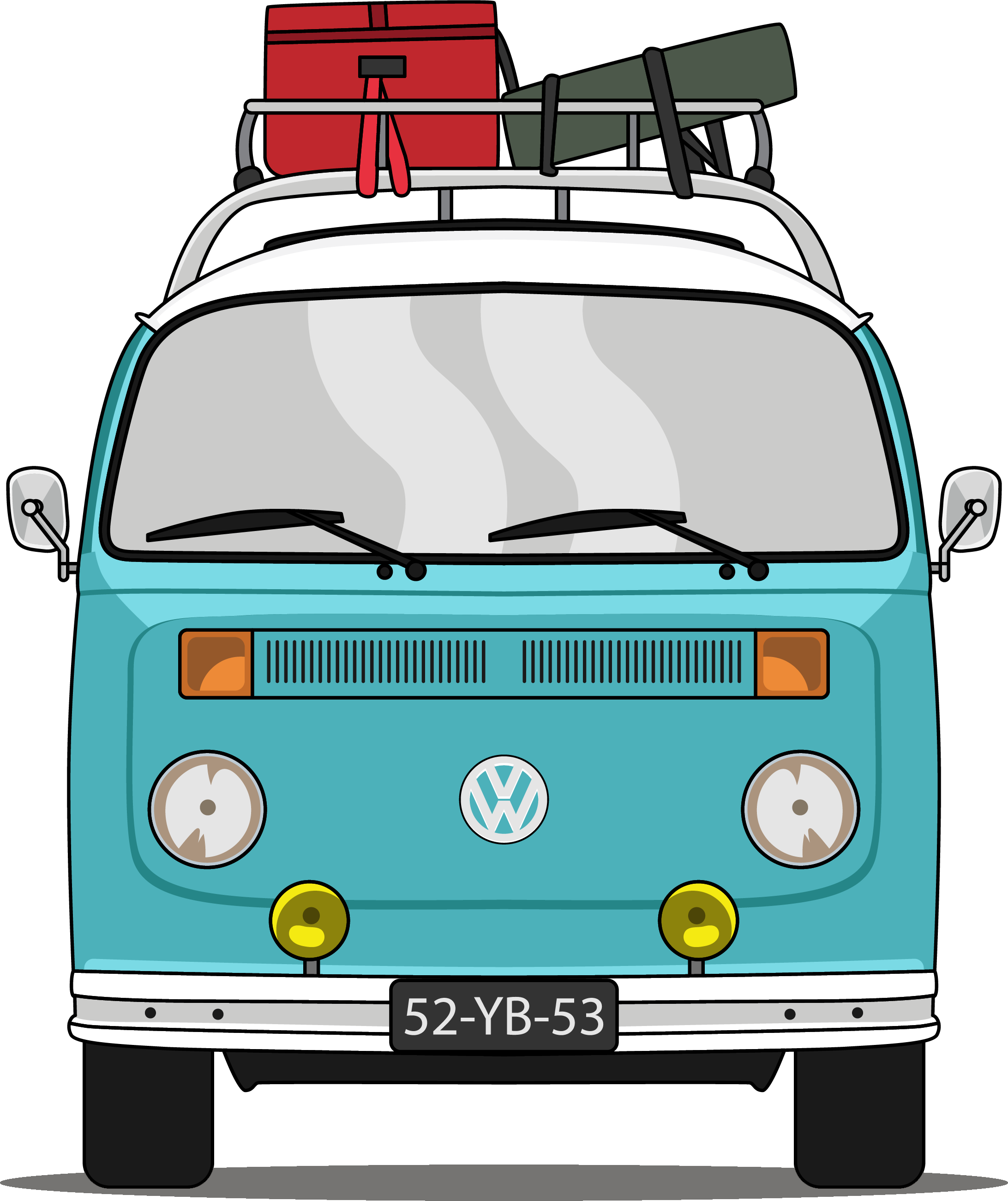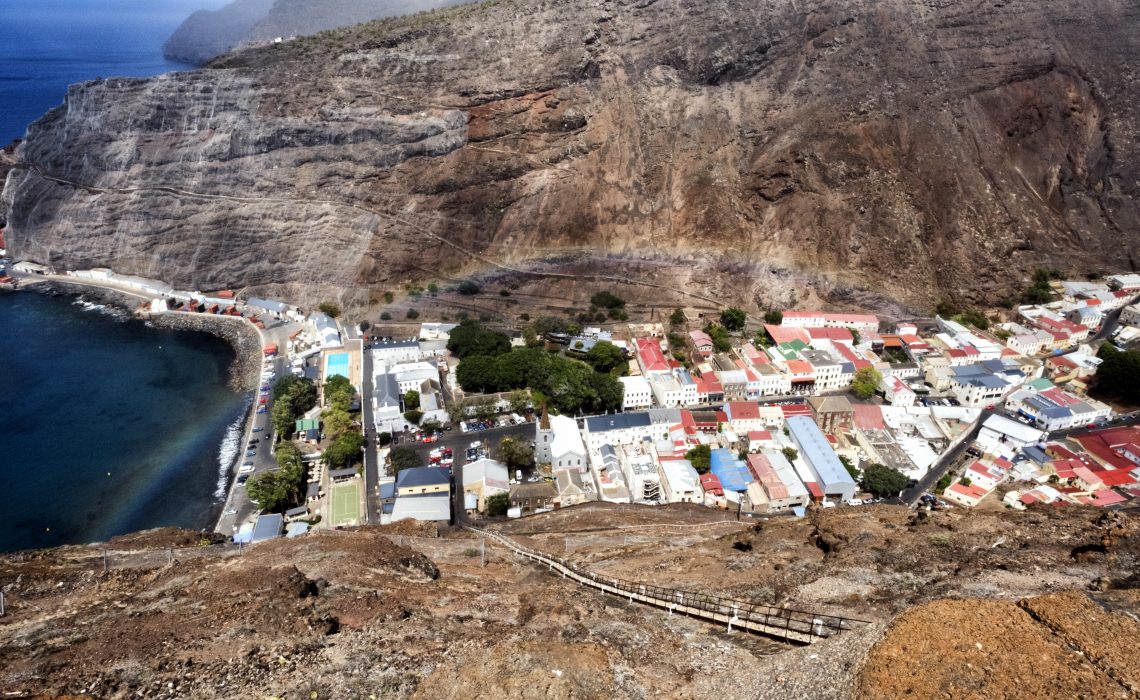Our goal for this entire trip is of course Saint Helena, an island about 4,000 kilometers from Rio de Janeiro and 1,950 kilometers west of Angola. Saint Helena is, of course, known as Napoleon’s exile, and he was not allowed to complain.
As with Tristan da Cunha, Saint Helena does not have a deep harbor, so we cannot get off the boat directly on land here either. But unlike Tristan da Cunha, the sea is a bit calmer here and we don’t have to use the rope ladder. Instead, a walkway is lowered onto a platform from which you then step into a boat. This boat does not hold 12 but 24 people. So unloading the passengers is a lot faster.
One last time I turn around and look at the Royal Mail Ship St. Helena (RMS) where we have very nice memories. I will never drink a beef tea again without thinking about the RMS. It was a special trip, because this trip was the second-last trip of the RMS. After this she will sail one more time from Cape Town to Saint Helena, to Ascension Island and back again. Unlike the British and the Saints, it doesn’t do much to me, for them it’s a tradition, a heritage. For me now and then doom and gloom.
Finally we are there! After 12 days at sea we are finally at our final destination: Saint Helena. We soon leave the customs office behind and start discovering Jamestown at our leisure. A beautiful town with artistic buildings dating back to the 18th and 19th centuries. Jamestown is built in the shape of a V in a narrow valley between 150 meter high cliffs. There is a wide street through it called ‘Main Street’ and a number of small streets that often lead to a dead end. Several restaurants and hotels can be found on the Main Street, as well as two small souvenir shops and two supermarkets, which are closed on Wednesday afternoons. There is a post office and a local hangout located in front of ‘the Market’. There are two pubs in the village, diagonally opposite each other and a little further on is a school.fish cake by the way ”.

Dutch on Saint Helena
On our travels we often encounter a history that is less known to us in which the Dutch more often than not played a leading role. Similarly, on Saint Helena.
We decide to take a look at Jamestown’s only museum ‘The Museum of St. Helena’, which is located next to Jacob’s Ladder (a staircase of 699 steps that Jamestown with Half Tree Hollow). The pleasantly and conveniently arranged museum opened in 2002, five hundred years after the Portuguese discovered the island, and can be visited free of charge. “The island was in Dutch hands for a while,” the museum’s curator tells me. “There is no evidence of this, but it is said that the Dutch came here in 1633 and left in 1651. After all, you already had the Cape of Good Hope. ”

Jacobs Ladder (699 steps).
Right at the entrance of the museum is a huge eye-catcher: the cannon of the White Lion, a Dutch VOC ship that went down here. De Witte Leeuw was built in 1601 in Amsterdam and sailed to Asia and back many times. In 1603 the ship was on its way to the Netherlands with three other Dutch ships, loaded with spices, jewelery and other goods from Asia. As the ships approached Jamestown, they saw two Portuguese ships. The Dutch attacked the ships but did not know the waters of the Jamesbay. And one of the Portuguese ships was soon able to sink the White Lion, after which the other Dutch ships fled.
In addition to The White Lion and the Boer War, we also find a painting about Willem Merk. Willem Merk was a drug trafficker and is the only person who ever escaped from the island in a self-made boat. In the painting, which he painted himself, we see Speery Island, in the south of Saint Helena, and a sailing ship sailing away. The painting is also accompanied by a newspaper article from July 31, 1994: ‘Fleeing Dutchman’s 2,000-mile escape. Jailbreak drug runner sailed alone across Atlantic in makeshift dinghy. ‘ With the help of the Dutch embassy in Brazil, he was able to fly back to the Netherlands and was not extradited to the British. According to the article here, this was because in the Netherlands the possession of soft drugs is punished less severely and he had already been imprisoned for three years for the smuggling.
We leave the museum and walk through the photogenic Jamestown. I decide to buy some souvenirs and immediately send some tickets. Of course, after two weeks without WiFi, an internet moment at Anne’s Place cannot be missed. This turns out to be a super nice spot in the castle gardens.

Diana’s Peak, highest spot on the island (823 m). Photo: Milene van Arendonk
The dependent island
Then we decide to go for a drive with our rental car. Driving across the island by car is great, from bare steep cliffs we suddenly end up in a paradise tropical area. Suddenly, a strip of flax plants along the road obscures our view. At the beginning of the 20th century, a new economic function was found for the island: the flax plant. Introduced from New Zealand, it dramatically reduced native plant species. Rope was woven from the flax, which was used, among others, by the British postal service to bundle letters. The flax industry was the main source of income for the island until 1966. The island’s economy collapsed when the British postal service switched to synthetic rope. Brian, who we know from the boat, tells us that no new source of income has ever been found since then and that Saint Helena is heavily dependent on British support. “Every year we receive about sixteen million euros in subsidy” says Brian. When asked whether the fishing industry can improve the economic activity of the island, Brian indicates that very little is being caught around the island.

The flax plant on Saint Helena.
But in addition to flax and fish, there may be another economic highlight on the island: coffee ! Napoleon once said “the only good thing about St Helena is the coffee” . On February 10, 1733, the first coffee beans were brought to the island. These came from Yemen with Captain Philips’ ship the ‘Houghton’. Brian’s wife Brenda is convinced that the coffee is the best in the world. “Our coffee has won several awards,” she says proudly. When I enter a souvenir shop to buy this award-winning coffee, I soon find out that the St Helena coffee is not only national pride but also quite expensive. “It is the most expensive coffee in the world”says the saleswoman. I will soon taste whether it is worth this price. But I doubt whether this can become a stable source of income for the island.
But perhaps the airport, formerly known as the ‘ most useless airport in the world ‘, can attract a new economy: tourism. The Saints are quite reserved about this and despite wishing everyone a good day and waving to everyone, many Saints would rather see tourists go than come.

